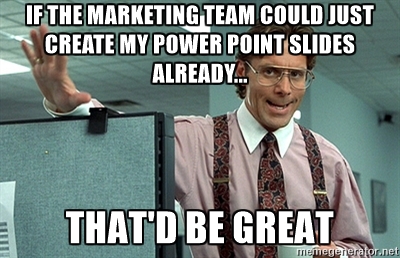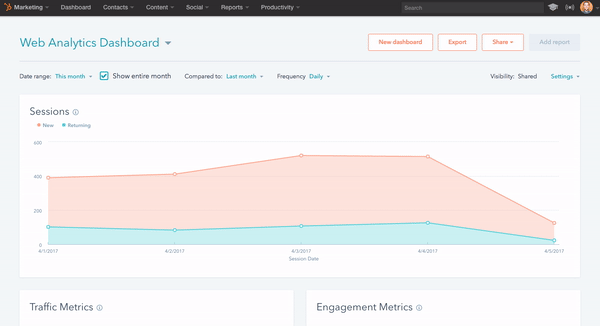Feeling a disconnect between your sales and marketing teams? You’re not alone. Many clients cite a breakdown in communication as a major problem in not only meeting their revenue goals but in overall job satisfaction.
To bridge the gap, stop thinking about marketing and sales as opposing entities and start looking at them as one unit: your revenue growth team.
When communication is open between teams, and expectations and goals are clearly set, not only will your sales engine be more effective, but your employees will be happier. Here are some common problems with sales and marketing misalignment and how HubSpot marketing automation and sales enablement tools can help you overcome them:
Sales & Marketing Team Problem #1: Communication
Marketing and sales are often seen as two separate teams, which can create communication problems, tension, and ineffectiveness when it comes to reaching your business goals.
According to a study conducted by Fierce, Inc., 86% of those surveyed cited ineffective communication as a leading cause of workplace failures, which can have major implications for your business goals. Not only can interdepartmental communication issues create a lack of trust and understanding among your team members, but it can also result in lost deals.
Solution: Open a Dialogue
When you onboard with a HubSpot Agency Partner, your current marketing and sales efforts will be audited to identify holes in your content strategy, contact segmentation, and follow-up processes, and identify potential solutions.
During this process, your team may be asked to identify things like how leads are qualified, what personas you have identified, and what benchmarks are set to measure the success of the marketing and sales team. This helps to establish open communication among your team members and encourages them to check in regularly after HubSpot is deployed, whether with an agency partner or independently.
Sales & Marketing Team Problem #2: Setting the Right Goals
Sales and marketing typically have different objectives, but when your ultimate goal as a leader is to grow your business, this misalignment can have consequences for your bottom line.
Solution: Use Analytics to Create SMART Goals
Utilizing HubSpot software can encourage your revenue growth team to work together to set goals.
By using analytics tools to track website pages, campaign success, email performance, social media interaction, and more, your marketing team will have the visibility they need to measure the success of their efforts and set SMART goals. Working backward, they can estimate the marketing cost per lead and adjust their spend to deliver the most qualified, bottom-of-the-funnel leads for their sales counterparts.
For sales, having an active history of sales and marketing interactions can help them identify what tactics work best, and what the average touch points are to convert a lead into a customer.
During quarterly business reviews, the revenue growth team can take a look at what worked and didn’t work over the last few months and set achievable goals together based on the analytics and overall sales. This will not only increase the productivity and value of your team but create a more open and honest work environment.
Sales & Marketing Team Problem #3: Establishing Accountability
Sales has a quota, marketing has lead/traffic goals. Whether sales are down or leads are only trickling in, someone on the team is catching the blame. It’s time for your team to stop pointing fingers and establish accountability.
Solution: Create a Service Level Agreement (SLA)
HubSpot contact records feature a timeline of your contact's interactions with your marketing and sales teams. You can see their web and email activity, conversation records, contact properties, lists, or workflows they’re assigned to, and more.
This will not only help hold your sales team accountable when communicating with leads, but will help your marketing team see how their efforts are impacting sales follow-up, and whether more time needs to be spent researching buyer personas, revisiting messaging and branding, establishing workflows and lists, etc.
Not all the generated leads are going to be qualified, and lead scoring is one of the many ways that HubSpot can help your marketing team curate a list of qualified potential clients.
By assigning values to certain variables (such as location or company size), HubSpot automation tools can help determine the salesworthiness of a lead and enroll them in corresponding lists or workflows so that they receive more immediate and relevant follow-up.
This leads to better expectations of not just the quantity, but the quality of leads generated, and helps everyone identify the current sales and marketing process and any weaknesses or strengths they may have.

Sales & Marketing Team Problem #4: Executing
Reaching the right people at the right time can be more difficult than it sounds. Cold calls don’t work. Mass emails to unqualified, uninterested leads don’t work. So then, how do you find and capture that unicorn lead? The one who’s educated on their problem, knows what solution they want, and is itching to purchase your products or services?
Solution: The Inbound Methodology
It’s all about inbound. Inbound is the fundamental practice of being where your leads are with education, solutions, and support. The Inbound Methodology is the core of HubSpot and can help your revenue growth team communicate, set goals and expectations, and ultimately close deals.
Using marketing automation tools like lists and workflows, you can create various contact lists based on properties such as original source, buyer persona, lead score, contact owner, or campaign involvement, and create and automate targeted and appropriate follow-up and nurture content. Lists can also be used to create smart content that displays targeted images or messages to your contacts based on different properties.
Once leads are in the CRM and have been segmented into lists, sales enablement tools help standardize and optimize your sales follow-up process. Your team can create sequences and tasks to remind them when to follow up with leads, and the contact record will help inform them on where the leads are in their buyer’s journey, how qualified they are, and what their challenges are, among other things.
In Closing
Uniting your marketing and sales teams can be one of the most valuable things you do for your company. By building and nurturing a revenue growth team with the sales enablement and marketing automation tools available with HubSpot, you are helping your team work together to deliver success.
Choosing to work with a certified HubSpot partner will ensure you get the support you need to make the most of your marketing and sales tools, and with LAIRE, you’ll get a comprehensive audit and Marketing Action Plan by LAIRE® to help you accurately identify and achieve your business goals.
Ready to learn more?



